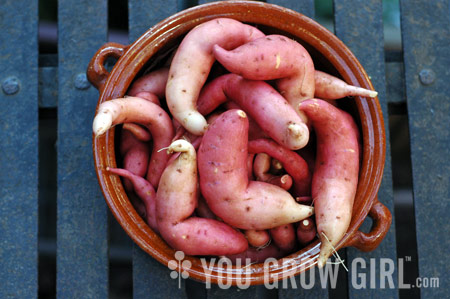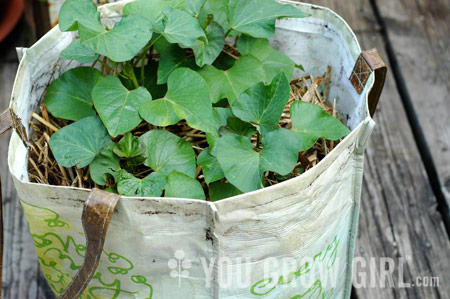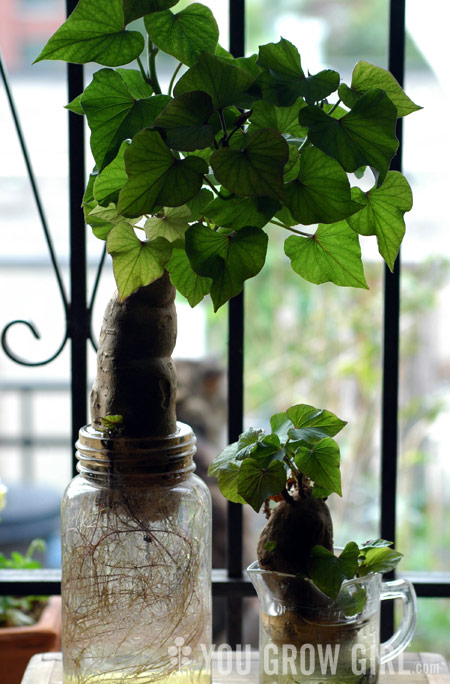
My most recent Globe and Mail Kitchen Gardening article is on sweet potatoes and chronicles an experiment I took up by chance, growing sweet potatoes in a shopping bag.
While in Dominica I learned that when there is not enough soil fertility to produce tubers, sweet potato leaves are cooked or steamed like spinach. I haven’t tried it yet, but think this would be a good option when starting the plant too late in the growing season. I have some slips on hand right now that I might plant for this reason.
————————–
Like most rabid gardeners, I spend the winter months concocting elaborate fantasy versions of my inadequately undersized growing spaces. When it comes down to what goes into the soil at planting time, however, happenstance seems to rule the day. I don’t plan my gardens; they plan themselves.
And I wouldn’t have it any other way. Some of my most exciting growing experiences and experiments have come about by chance. Take sweet potatoes (Ipomea batata) as an example. I’d been growing regular potatoes for ages, but had avoided the tropical, super-sweet tuber. Mention growing them and gardeners go grim. “Forget it. Our season isn’t long enough,” they cry. “And the damn things take up too much space.”
They are right. Sweet potatoes require a notoriously long growing season — about 100 to 140 days to be exact. And unlike regular potatoes, their meandering, snaking vine grows like a giant’s intestines. In my tight confines, the odds seemed against me, so I acquiesced until a tuber bought at the local farmers’ market sprouted on top of my fridge and forced my hand. How could I not try to grow it? But where would I put it?

All of my pots and bed space were accounted for and I simply refused to go out of my way for a plant that wasn’t on the agenda and might not produce. That’s when I thought of grow bags. British gardeners have been successfully growing in soil-filled bags for years. Grow bags from pre-filled poly versions to reusable cloth bags are now used to grow all manner of crops that are tricky to keep alive in the ground. So why not dump some potting soil, I thought, into one of the stacks of over-sized green tote bags I’ve collected over the years and call it a “grow bag.”
Here’s how I went about it.
Big tubers need lots of soil space to grow, so use the largest tote bag you can find or sew one yourself using breathable landscaping cloth. My bag was not cloth so I cut holes into the bottom and some into the sides to create good drainage; if you don’t do this, your plants will rot. Fill the bags with well-draining potting soil, not soil dug out of the garden.

The plants themselves are produced from cuttings called slips. You can make an unlimited number of slips yourself from a single sweet potato purchased from a market or organic food store. Start making them in early spring — about a month before the last frost in your area — so you can meet the plants’ long-season demands. Simply stand the potato in a jar of water so that about a third to a half is submerged in the water. Set it in a sunny windowsill where it will form little shoots and leaves within a few weeks. When the shoots are about six inches long, carefully twist or “slip” them off of the potato. Some gardeners put these slips into water or very wet sand to produce roots before planting; I, however, have placed the rootless slips directly into soil with success. The trick is to keep the soil moist (not soggy) and the bag or pot out of the hottest sun until the plants are established. About two or three slips is all you need for a typical tote bag. Don’t forget that sweet potatoes are a tropical that do not like cold weather or frost. Wait until well after all danger of frost in your area has passed before setting the plants outdoors.
And that’s it. For all the fuss, they really are an easy crop to grow. And pretty too. Even the boring varieties will produce lush, tumbling green vines with flushes of purple in the newest growth. Colourful, ornamental varieties produced for the annual plant market are also edible. You may have noticed tubers in your own pots and hanging baskets at the end of a particularly warm growing season — eat them or save them for next year’s plants. Unfortunately, ornamentals are not as productive as those grown for food so you are better off with the regular varieties if you want a good crop.
Just before the first frost, turn the bag over onto a plastic sheet or dig out the tubers. I got four pounds. Not bad for a crop that cost me nothing and I had never intended to grow.
Great idea with the potatoes, I’ve also heard of people growing them in yard waste bags, or if you’re willing to give up the space you can grow them well in garbage barrels (preferably cleaned and emptied.
Also Gayla, off topic but do you know anything about growing Eastern Redbud (cercis canadensis) in the GTA?
The community center I volunteer is using large burlap bags (donation from coffee roaster) for similar gardening projects.
Great info on how to start!
I planted sweet potatoes this year and they are going crazy! I can’t wait to dig the little guys up.
my mother in law starts them in the house like you did and grows them in a really big pot (in BC) I didn’t know you could grow them here until I saw hers.
Amazing! This is my 2nd year growing sweet potatoes, but I never knew you could eat the leaves. I guess I figured – though they’re not related to conventional potatoes – that the leaves would be poisonous, too.
Here are my sweet potatoes in a hanging planter – but next year, I must try growing these in a bag!
http://ronypony.blogspot.com/2010/07/hanging-things-2010-part-deux.html
Ok I’m obviously the real newbie with this, but could you clarify for me what a slip is? What am I twisting off and what am I putting in the bag? Thanks!
Julie: In the photo above, the slip is the plant part that is still attached to the original sweet potato. You can twist it from the potato very easily and it will grow roots.
Cool- I know my little ones will go for this. I just wish it was spring so that I had time to do this in Chicago weather.
Thank you!! I think I’m going to try this!
How great to see you write about this! My sweet potatoes sprouted for me & I thought it a shame not to try growing them, so I put them into some pots in my greenhouse. Experiment, experiment, experiment!! Even if I don’t have much of a harvest, it’s still fun to try new things in the garden & find out how others do this as well!
Thanks for the pictures!
This is awesome. I am a 2nd year gardener and learning new space savings tips for producing wide spreading plants just makes my day. Thanks!
Gayla, THANK YOU!! I have been unsuccessfully attempting to cultivate ‘Sweet Potatoes’ for two years. This is a fantastic idea and the instructions are perfect… I think:) will report back in a few months:)
I adore your site and would love to blog roll your site on mine would you mind??
Off the subject would you know where I could buy some of your beautiful flowers (seeds) featured on this site and orange, lime and mystic thyme seeds and also Boston Red Jerusalem artichokes?? a lot but I didn’t want to waste your time:) LOL!!!
PS I am in New Zealand and specialize in heirloom vegetables, fruits and nuts and rare plants.
Thank You for the great site
Organic Suzi: I don’t know where you can get seeds in New Zealand. Not sure if any of the American suppliers ship there.
Thank you it’s difficult for us to get access to seeds outside NZ because of our restrictions… working hard on that one:) Thank you.
Very interesting. I had wanted to try sweet potatoes this year but ran out of time (and space). I do have a spare galvanized metal garbage can that would be perfect, although I might try 4 or 5 inches of gravel/rock to avoid punching holes in the bottom of the can.
With research, I’m sure I could find a variety with a shorter growing season?
Yeah, I planted some sprouts that I cut off a couple of sprouting sweet potatoes. The vines are growing great, but I don’t know if they will produce good-sized tubers, as they are in a 5-gallon bucket.
I love this idea! Gayla, would this work indoors? I’d like to try it this year but I live in Brooklyn. If I use a grow light would a slip produce yams for the spring time?
Jennifer: As long as the grow light is strong, it should work.
You’ve got a great site here. I’m not yet a serious gardener but I grow some veggies in my backyard. It’s easy growing theme here in the tropics. Here in the Philippines we steam the leaves of sweet potatoes, add tomatoes, garlic and a little vinegar for salad. There’s also a variety we put in our fish stew.